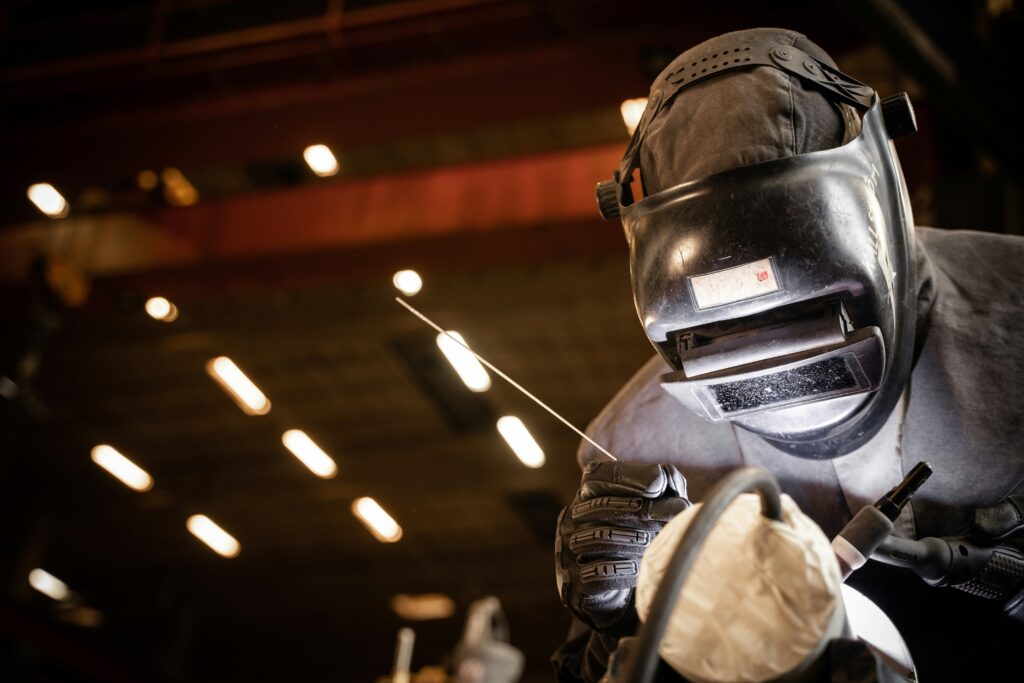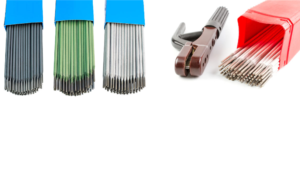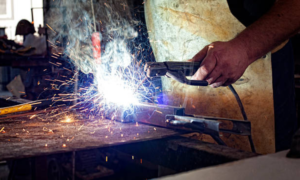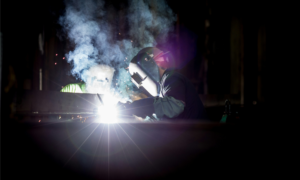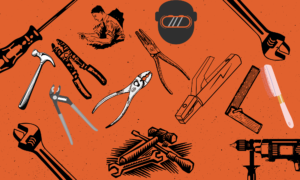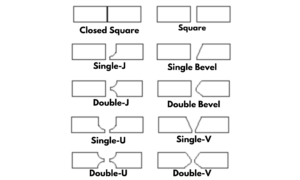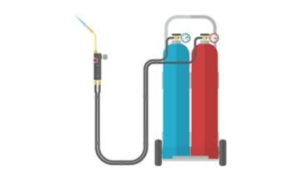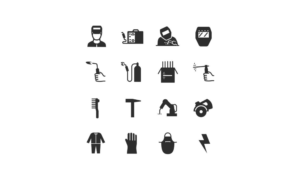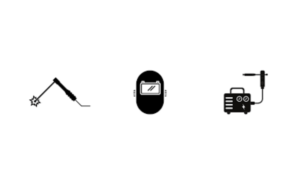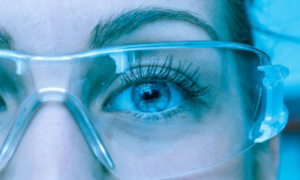The heat during shielded metal arc welding (SMAW) originates from an electric arc. This arc forms between a consumable electrode and the workpiece.
Shielded metal arc welding, commonly known as stick welding, is a fusion welding process used to join metals. An electric current, either alternating current (AC) or direct current (DC), creates an intense arc that melts the electrode’s metal coating, generating a protective gas shield.
This gas shield stabilizes the arc and protects the molten weld pool from atmospheric contamination. The heat from the electric arc is sufficient to melt both the electrode and the base metal, resulting in the coalescence of materials to form a strong joint. This welding technique is versatile and widely used in construction, repair work, and industrial fabrication due to its simplicity and cost-effectiveness. Skilled welders value SMAW for its portability and ability to work with various metals and thicknesses.

Credit: www.sciencedirect.com
Basics Of Shielded Metal Arc Welding
Core Components Of Smaw
The SMAW system consists of several key parts:- Power Source: Provides the electric current required for welding.
- Electrode Holder: A tool that holds the electrode securely.
- Welding Electrodes: Rods coated with flux that produce the weld.
- Ground Clamp: Creates the circuit by grounding the workpiece.
- Personal Protective Equipment (PPE): Includes helmets, gloves, and aprons to protect the welder.
The Smaw Process
SMAW follows these simple steps:- Secure electrode into the holder.
- Connect power source to electrode and ground clamp.
- Place ground clamp on the workpiece.
- Turn on the power source.
- Strike the electrode against the workpiece to start the arc.
- Melt the metals at the joint, moving the electrode steadily.
- Allow the weld to cool and solidify for a strong bond.

Credit: www.researchgate.net
Heat Generation In Smaw
Electrical Energy To Heat
To start, SMAW needs electricity. An electric current passes through materials. These materials don’t pass electricity easily. So they resist the current. This resistance turns electrical energy into heat.- The electricity level is high.
- Material resistance is significant.
- Heat jumps up as a result.
The Role Of The Electrode
An electrode plays a key part. It carries the current. Then, it touches the metal. This sparks an arc. It’s very hot, like the sun.- Electricity moves to the electrode.
- The electrode touches metal parts.
- An arc forms, giving off heat.
The Electrode’s Contribution
Electrode Composition
An electrode is more than a mere stick. It comprises a core wire coated in flux. The wire conducts electricity, creating the arc. The flux protects the weld area from contamination. Electrodes also categorize by the materials they contain, such as:- Mild steel for general purpose welding
- High-carbon steel for stronger welds
- Stainless steel for corrosion resistance
- Aluminum and nickel for specialized jobs
Melting And Deposition
The electrode’s core wire melts into the weld pool once it hits the workpiece. This melting action is where the real magic happens. Let’s break it down:- The electrode tip touches the work, igniting an arc.
- Intense heat from the arc melts the wire.
- Molten metal drips into the joint, joining the materials.
Chemical Reactions And Heat
Flux Ingredients And Their Functions
At the core of stick welding lies the electrode’s flux coating. This not only shields the weld area from contaminants but also plays a pivotal role in heat production. Let’s look at the key components:- Cellulose – Burns to create a gas shield and adds carbon to the arc.
- Iron Powder – Serves to increase deposit efficiency and improve the arc.
- Minerals and Alloys – Stabilize the arc and control the metal’s properties.
- Binders – Maintain the coating’s integrity during welding.
Exothermic Reactions Within The Flux
The real magic begins as the welding arc ignites. The heat triggers exothermic reactions. Not only do these reactions release more heat, but they also envelop the weld pool in gases that shield it from the atmosphere.| Reaction | Output | Heat Contribution |
|---|---|---|
| Cellulose burning | C02 + H2O (vapor) | Substantial |
| Iron Powder melting | Additional molten metal | Moderate |
| Minerals decomposing | Stable arc and slag formation | Variable |
Factors Affecting Heat Production
In shielded metal arc welding (SMAW), the heat generated is crucial for creating strong joints. Several factors influence this heat production. Understanding them can improve welding outcomes. Let’s delve into the key elements:
Current And Voltage Settings
Current and voltage directly impact the heat produced in SMAW. The settings chosen will dictate the temperature and size of the arc. An increase in current boosts heat, facilitating deeper penetration. Conversely, lower current reduces the heat, aiding in welding thinner materials. Each metal demands an optimal current range for effective welding.
- Ampere (A): Measures current strength.
- Volt (V): Defines the arc’s potential difference.
Voltage, meanwhile, influences the arc length. A higher voltage leads to a longer arc, which can cause excessive spatter. A balanced combination of both delivers the desired heat.
Electrode Size And Type
The choice of electrode significantly affects heat during SMAW. Electrodes come in various sizes and compositions, each designed for specific tasks.
| Electrode Diameter | Heat Output |
|---|---|
| Small | Less Heat |
| Large | More Heat |
Thicker electrodes generate more heat, aiding in penetrating thicker materials. The electrode’s material also contributes to the heat. For instance, electrodes with a cellulosic coating create intense heat which helps in deep penetration welds. Type selection should align with the workpiece to ensure proper fusion. The composition and coating can also affect the slag formation and arc stability. A precise understanding of these factors allows welders to adjust their technique for desirable results. It’s the careful calibration of these elements that yields efficient, strong, and reliable welds.
Safety Practices For High Heat Welding
Personal Protective Equipment
The first line of defense against high heat during welding is proper attire. Employ the following gear:- Welding Helmet: Shields the face and eyes from sparks and intense light.
- Fire-Resistant Clothing: Prevents burns from hot metal and flying sparks.
- Gloves: Thick, insulated gloves protect hands from heat and electric shock.
- Leather Apron: Covers and safeguards the body.
- Safety Shoes: Prevents foot injuries from falling objects and sparks.
Managing Thermal Hazards
Controlling the heat in the welding environment is crucial. Implement these tactics:- Keep flammable materials away from the welding area.
- Use insulated mats in areas prone to electrical hazards.
- Ensure proper ventilation for reducing fume buildup.
- Regular breaks help to cool down both the welder and equipment.
- A fire extinguisher should be within reach at all times.

Credit: leadrp.net
Frequently Asked Questions For What Produces The Heat During A Shielded Metal Arc Weld
How Is The Heat Created For Shielded Metal Arc Welding?
The heat for shielded metal arc welding (SMAW) is generated by an electric arc formed between a consumable electrode and the metal workpiece.
Where Does The Heat Come From When Arc Welding?
The heat during arc welding originates from the electrical arc created between a consumable or non-consumable electrode and the metal being welded.
What Determines The Exact Temperature Of The Shielded Metal Arc?
The temperature of the shielded metal arc is determined by the amperage setting, electrode size, and the type of current used. Proper adjustment of these factors ensures optimal welding temperature.
How Does Shielded Metal Arc Welding Work?
Shielded metal arc welding (SMAW) uses an electrode coated in flux to lay the weld. An electric current forms an arc between the electrode and metals, melting them to form a joint. The flux coating disintegrates, shielding the weld from atmospheric contamination.
Conclusion
Wrapping up our exploration of heat generation in shielded metal arc welding (SMAW), we’ve uncovered key factors. The electrical arc, friction, and metal resistance are pivotal. These elements synergize, creating intense heat essential for welding success. Keep these in mind for a robust understanding of SMAW processes.

